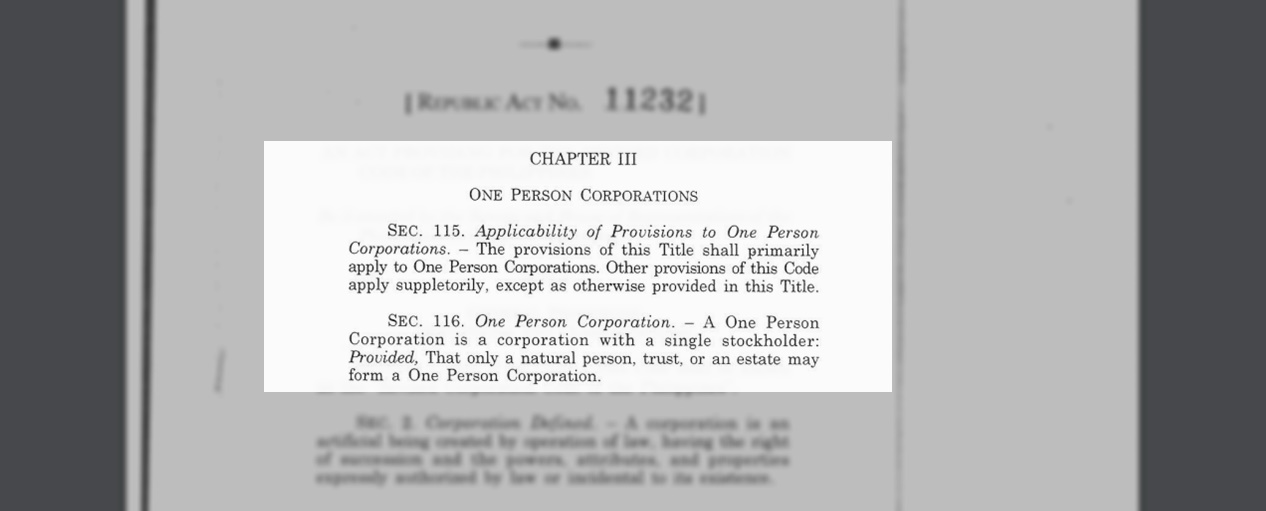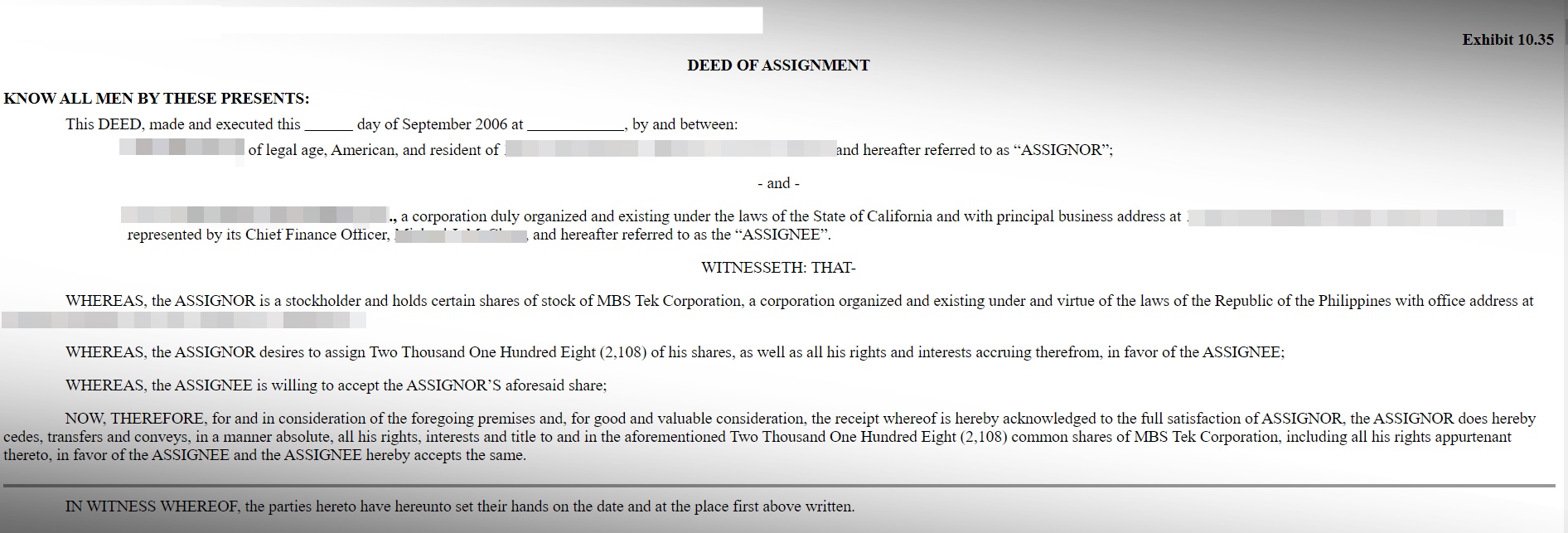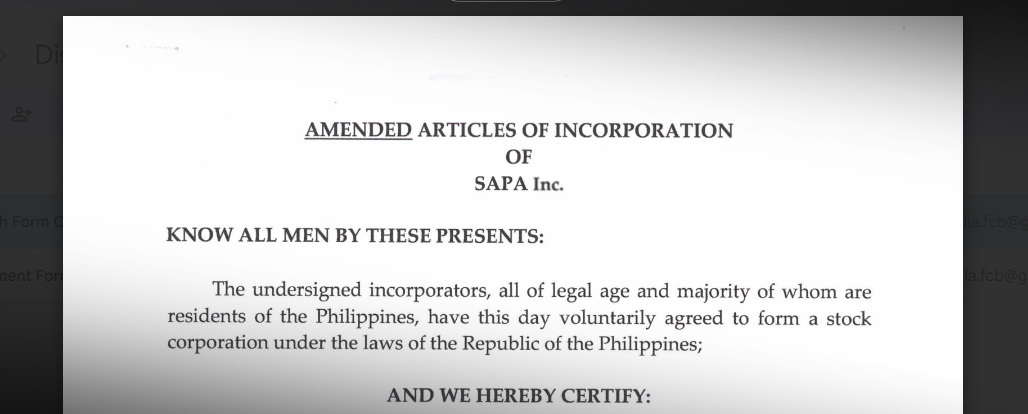How to transfer ownership of a One Person Corporation?
Contents
- What is a One Person Corporation?
- What are the laws that govern the transfer the ownership of a One Person Corporation to another Person?
- Why is a formal transfer of ownership needed?
- What is the process and how long does it take to transfer the ownership of an OPC?
- What are the documentary requirements to transfer the ownership of an OPC at the BIR and SEC?
What is a One Person Corporation?

The One Person Corporation allows the creation of a company with only one stockholder.
A One Person Corporation (OPC) is a new type of juridical entity created through the passage of R.A. No. 11232 or the Revised Corporation Code of the Philippines.
This came into effect on February 23, 2019.
An OPC is unique from a common corporation as it is created with only a single stockholder vs the five or more stockholders required of a common corporation.
An OPC is a distinct and separate entity from the sole stockholder. This allows the stockholder to be protected from corporate liability. This can be challenged in certain situations and generally a corporation has stronger liability protection.
As OPCs are relatively new in practice, their creation and provisions in the law are subject to different opinions and interpretations.
As you will see later on in this article, this interpretation can lead to certain issues.
What are the laws that govern the transfer the ownership of a One Person Corporation to another Person?

An OPC can be sold and transferred to a new owner by transferring shares
Similar to that of a normal corporation, the stocks of the sole stockholder of the OPC can be transferred from one person to another.
The provisions of R.A. 11232 provide for the establishment of an OPC. These are specifically found in Chapter III, Sections 115 to 132.
The Securities and Exchange Commission (SEC) also issued Memorandum Circular No. 7, Series of 2019 which has a subject “Guidelines on the Establishment of a One Person Corporation.”
However, both are silent as to whether an OPC can be transferred to another person.
To answer this, we need to apply the rules of the other provisions of the Revised Corporation Code as a supplement to the rules on OPC.
Section 115 of the Revised Corporation Code provides that other provisions of the Revised Corporation Code apply suppletory, except as otherwise provided in the Title for OPC.
Thus, the applicable provision is Section 62 of Title VII, Stocks and Stockholders of the Revised Corporation Code.
Section 62 provides for the right of a stockholder to transfer his or her shares and the requirements that must be complied with for the transfer to be valid.
To transfer, the new owner or transferee must prepare a Deed of Assignment or Transfer of Stock or Interest.

A deed of assignment must be duly signed by both parties and notarized
The Deed must provide the information that the transferor is assigning his or her shares or stocks to the transferee. The number of the stocks or shares must be properly documented with the amount of the agreed valuation for the transfer.
This Deed will act as security for the transferee and will be a basis for the recording of the transfer or assignment in the books of the OPC.
In the case of Teng vs. SEC and Ting[1], the Supreme Court of the Philippines acknowledged the execution of a deed of transfer of shares of stocks as prima facie proof of ownership of the transferee. This document was also used later on as the basis for recording the transfer of stocks in the books of the corporation.
To summarize, under Section 62 of the Revised Corporation Code, the following are required to have a proper transfer of stocks:
- The Certificate of Stocks must be delivered to the new owner;
- The Certificate must be properly endorsed;
- Deed of Assignment (Transfer of Stock or Interest);
- The transfer must be recorded in the books of the OPC.
[1] G.R. No. 184332, February 17, 2016.
Why is a formal transfer of ownership needed?

The owner cannot protect his rights and is not recognized as the corporation’s owner if the shares are not in his name.
There are several benefits why complying with the requirements are important.
They are as follows:
- To enable the transferee to exercise all the rights of a stockholder;
- To inform the corporation of any change in share ownership so that it can ascertain the person entitled to the rights and subject to the liabilities of a stockholder;
- To avoid fictitious or fraudulent transfers,
- The right to have stocks transferred to his or her name;
- The right to demand for the issuance of stock certificates
Without the formal transfer of ownership, the owner cannot defend his rights and is not the acknowledged owner of the corporation.
Just like any other transfer of ownership procedures, this one is also subject to taxes.
Capital gains tax and documentary stamp tax should be paid aside from the sale or donation amount.
You must settle these taxes first before you can proceed with the registration of the stocks to your name.
Capital Gains tax is the tax to be paid based on the net gain from the transfer.
The net gain is computed from the difference between the market value of the stocks and the amount from the sale of the stock. Then the net gain is multiplied by 15%.

Transfer costs include the processing fee and payment of necessary taxes
The Capital Gains Tax Return shall be filed and paid within thirty (30) days after each sale, barter, exchange, or other disposition of shares of stock not traded through the local stock exchange.
Payment must be made with any Authorized Agent Bank (AAB) under the jurisdiction of the Revenue District Office (RDO) where the seller/transferor is required to register.
The documentary stamp tax is normally paid upon the issuance of the eCAR or the Electronic Certificate Authorizing Registration.
The DST is Php1.50 on each Php200 of the par value of the shares of stock sold. The DST is to be paid in the same Revenue District Office where the Capital Gains Tax is going to be paid.
What is the process and how long does it take to transfer the ownership of an OPC?

The requirements must be filed at the BIR RDO where the business is registered and at the SEC
The process to transfer the ownership of an OPC is first preparation of documents, submission and payment at the BIR, and then submission of the amended AOI at the SEC.
The detailed steps are:
- Prepare the Deed of Transfer, this includes the settlement of the sale of the stocks;
- Prepare the Stock Certificates;
- Settle the Tax Implications to the BIR RDO concerned;
- Submit the Deed of Transfer and the Stock Certificates to the OPC and eCAR to be issued by the BIR after settlement of the tax implications;
- Registration of the transfer in the Books of the OPC;
- Issuance of the Certificate of Stocks;
- Preparation of the Amended AOI and other SEC documentary requirements;
- Submission to the SEC of the documentary requirements for the amendment of the AOI;
- Issuance of the Certificate of Registration with the SEC-approved Amended AOI.

The process may take longer depending on how fast the government offices work
The process for the transfer of the stocks of the OPC to another person will take several months. Based on the summary of the processes and the volume of documents to be prepared coupled with dealings with several government agencies, the process for the transfer of the stocks of the OPC to another person will take several months.
The safest estimate that we can give is that the whole process may take from six months up to a year at most depending on how complete are your documents are and how efficient is the government body that you need to deal with is.
The estimate given is based on the experience of dealing with almost similar document preparations and the same government offices involved in previous transactions. Note that it can change depending on the specific circumstances of the case.
What are the documentary requirements to transfer the ownership of an OPC at the BIR and SEC?

Basic requirements are the Corporate documents and valid identifications of both parties
The documentary requirements for BIR are as follows:
Mandatory Requirements:
- TIN of Seller and Buyer;
- Notarized Deed of Absolute Sale/Document of Transfer
- Photocopy of stock certificate;
- Proof of acquisition cost
- Official Receipt/Deposit Slip and duly validated return as proof of payment;
- BIR Form 1707
- For shares of stocks not listed/not traded – Latest Audited Financial Statement of the issuing corporation with computation of the book value per share;
- For shares of stocks listed/traded – Price index from the PSE/latest FMV published in the newspaper at the time of the transaction;
You will first need to submit your documents at the BIR.
Then, you will need to pay taxes at the BIR to issue the eCAR.
The eCAR is a document that you must show to the Corporation so that the transfer of stock will be registered and the issuance of a new certificate of stocks under your name will be made.

An Amended AOI must be filed with the SEC upon payment of necessary fees
After that, You will need to submit amended Articles of Incorporation to the SEC.
Considering that the corporation involved here is an OPC, changes must be reflected in the Articles of Incorporation (AOI) to reflect the new stockholder.
The documents needed to be prepared and to submitted to the SEC for the amendment of the AOI are as follows:
- Amended Articles of Incorporation;
- Director’s Certificate;
- Secretary’s Certificate of No pending case of intra-corporate dispute
- CMD Clearance.
The first three documents are documents that can be and must be prepared by the OCP.
The last document is a document that will be issued by the Company Registration and Monitoring Division of the SEC.
To secure monitoring clearance, the requirements are as follows:
- Latest Audited Financial Statement (with SEC stamp received);
- Latest General Information Sheets (with SEC stamp received);
- Articles of Incorporation (w/ latest approved amendment, if any);
- Proof of Registration of Stock and Transfer/Membership Book (page with SEC stamp); and
- MC 28 Proof of Submission
The following requirements will then be submitted to the CRMD through email.
Once the CRMD issues the Monitoring Clearance, you can now proceed with the submission of the documentary requirements for the amendment of the AOI through email again.
Note that SEC now follows automated means of transacting them. Most of their transactions, if not all, are already through online submissions.






0 Comments